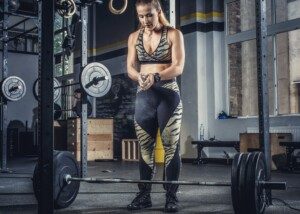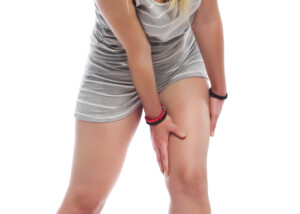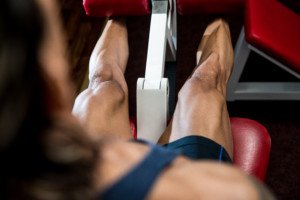
I injured the tendon that joins my quadriceps to my kneecap when I was doing ultra-heavy leg extensions.
I also figured out how to cure the “pain” at the junction of the tendon and quad muscle.
I didn’t go see a doctor because it wasn’t serious pain. As a former personal trainer, I was absolutely sure that it involved the patellar tendon. This tendon is used in the leg extension (“leg lift machine”).
So I self-diagnosed myself as having an injured quad tendon. The location of the funny discomfort was a dead giveaway to what was wrong.
The location was right where the tendon would be. Tendons join muscles to joints.
Secondly, I can differentiate between tendon pain and muscle pain. If you’ve ever had strained or injured tendons, you know what I’m talking about. The discomfort is unique, nothing like muscle discomfort.
It’s Easy to Overload Knee Joint with Heavy Leg Extensions
A common way of injuring a tendon is to overload it during weightlifting, which is exactly what I did.
As I was bringing my leg up during the extension, I suddenly felt this pain.
It wasn’t sharp like a knife, but it was very noticeable, and concentrated in a small area just above my kneecap.
Quadriceps muscles are very durable and strong. This was no quad injury. It was clearly the tendon.
When you injure a tendon, you almost always know it at the time of injury.
But when you strain, pull or over-work a muscle, oftentimes, you don’t feel it right away.
Guidelines for Healing and Restoring 100% of Your Tendon; Never Have Pain Again
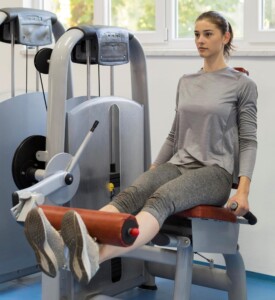
Freepik
1) Initially you must avoid the activity that caused the injury. Take a few weeks off from it.
2) However, after a few weeks, return to the activity.
3) Be patient. It took three years for my injury to heal 100 percent. What this meant was that it stopped acting up — zero acting up.
The “pain” was more of a funny annoying feeling that would come during some activities.
But over a three-year period, the intervals between “acting up” times got longer and longer.
Currently, there is no activity that brings on the funny feeling and this includes heavy leg extensions. It’s all history. EDIT: Nine years after this post, there’s still no sign I ever had quadriceps tendonitis.
But this wouldn’t be possible had I not done certain things to heal it.
Realize that the best way to heal a tendon is to do the very thing you’d never think of doing: Resume the very activity that caused the injury in the first place: leg extensions.
However, resume it at a fraction of the resistance. When I resumed leg extensions, I used much lighter weight.
I used weight light enough such that it did not provoke the tendon or bring out that funny feeling.
I normally did leg extensions once a week, so my therapy, then, was once a week.
It’s possible the healing rate would have been faster at twice a week, but I opted to do the leg extensions only once a week.
Over a long period of time I increased the weights.
You might also note that every time you do the activity that caused the injury, you can feel the pain.
If the pain is dull and not that bad, use a lighter weight and gently work through it.
When I did this, the discomfort actually disappeared at some point during the workout.
If I had discomfort before the leg extension workout, then when I was finished, the discomfort was completely gone.
I surmise this was because the workout pumped up blood circulation and loosened things up. Inertia is the last thing you want to do.
My advice pertains to relatively minor tendon injuries. Obviously, if you think you’ve torn a tendon and there is swelling, you should see a sports med doctor. I had no swelling, redness nor acute pain.
Returning to the offending activity, but with lighter weights (and VERY light if necessary), high reps and patience, is the way to go.
Foot Position Is Important
Make sure your feet are always at a 90 degree angle, rather than “floppy” or relaxed when using the leg press equipment.
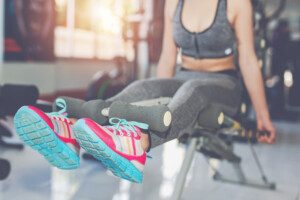
Note the foot position here; it’s incorrect. This can add strain to the knees. Toes should be pointed to the ceiling at the top of the movement. At the bottom of the movement, toes should be pointed slightly upward to ensure that at least a 90 degree angle is maintained. Freepik/jcomp
And when doing leg extensions, make sure the pad isn’t against your instep; this puts more stress on the knee joint.
 Lorra Garrick is a former personal trainer certified through the American Council on Exercise. At Bally Total Fitness she trained women and men of all ages for fat loss, muscle building, fitness and improved health.
Lorra Garrick is a former personal trainer certified through the American Council on Exercise. At Bally Total Fitness she trained women and men of all ages for fat loss, muscle building, fitness and improved health.
.

